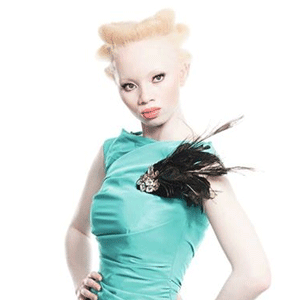
Thando Hopa grew up in the shade, her porcelain skin protected by long sleeves and sunscreen until the day the South African decided to fight prejudice against albinos by becoming a model.
Ghostly, with no make-up bar vivid fuchsia on her lips and hair sculpted to a magnificent bleached height, she exploded onto the cover of the first Forbes Life Africa back in 2013 (see picture to your right).
There are about 17 000 albino births in the Western world each year and one in 70 people carry the recessive gene for albinism, although it takes both parents carrying the gene for albinism to manifest.
In some parts of Africa, such as Tanzania, Malawi and Burundi, a person with albinism is thought to be a demon and are often hunted down and killed, despite local laws prohibiting it.
Their body parts are sought after by witchdoctors for their mystical powers and, if they are not killed, they are attacked and have hands, arms, or other parts cut off.
"It's one of the most beautiful pictures I've had taken," says Hopa, though it took years for her to grow comfortable with a bare face, her pale eyebrows almost invisible.
"I was much younger then. I could never go out without make-up...
But as time goes on, your confidence just grows," she says.
"It took years for me to get to a point where I could walk around without
Image: Thando Hopa and friends, from Twitter: @thando_hopa

'The most beautiful little girl'
"I had been approached to do modelling before, but I didn't go for it because I never saw the benefits. I thought, 'It's such a shallow profession -- why would I want to do that? I am a lawyer.
But after crossing paths with designer Gert-Johan Coetzee in downtown Johannesburg in 2012, she began thinking differently.
"Gert came to me and asked me if I would like to do a shoot and I said I would consider it," recalls
"And then I spoke to my sister. And my sister said to me, 'Don't look at modelling as modelling. Look at it as an opportunity for you to actually change
The third born in a family of four children - her youngest sibling was also born with albinism -
But even in South Africa, where reports of albinos being murdered and their organs trafficked are extremely rare, she encountered prejudice and misunderstanding.
Strangers hugged her as a symbol of good luck, others spat to fight her bad luck. Teachers misread her poor eyesight - a side effect of albinism - as her being mentally challenged.
Image: Thando Hopa photographed by Justin Dingwall for his Albus Exhibition

'When you were born I was shocked'
Thando Hopa grew up in the shade, her porcelain skin protected by long sleeves and sunscreen until the day the South African decided to fight prejudice against albinos by becoming a model
"The dress was gorgeous –- black and green. I can tell you, I have never felt so expensive in my life.
But I was actually so scared because in essence that was the first time I really walked in heels. I was even saying a little prayer when I was walking, 'God, please don't let me fall on this catwalk!' I was absolutely frightened."
For all it's brought her now, there was a time when
"I came crying, and I
"And you know, my father is a wonderful man, but he doesn't really know how to deal very well with emotions.
So he looked at
It's a memory she can laugh at now she's 25 and confident.
"On that day, more than anything, I wondered if my life would be
Image: Thando Hopa tries on an evening dress by fashion designer Gert-Johan Coetzee at his workshop on June 13,

Read more:
Darker skin doesn't mean melanoma immunity
Aspiring model brings awareness to Crohn’s disease




 Publications
Publications
 Partners
Partners










